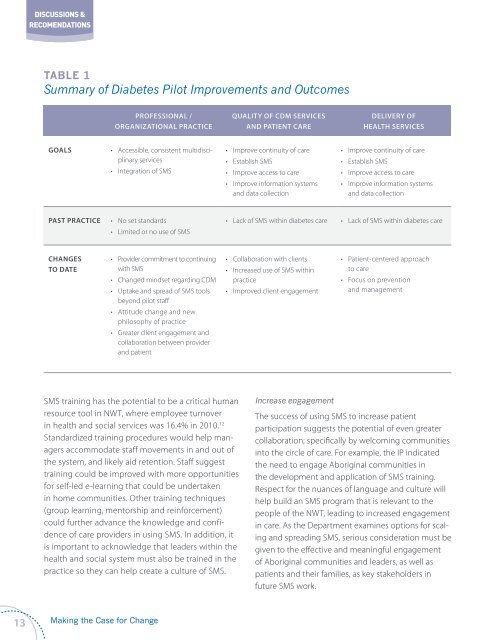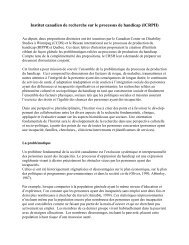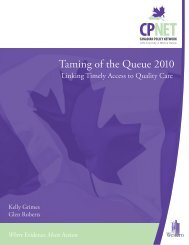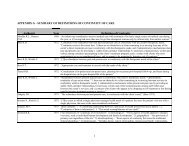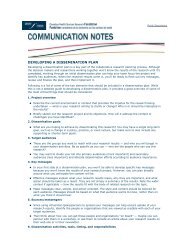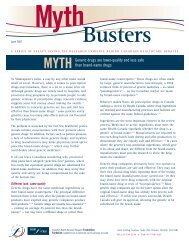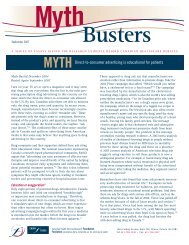Full Report
Full Report
Full Report
You also want an ePaper? Increase the reach of your titles
YUMPU automatically turns print PDFs into web optimized ePapers that Google loves.
DISCUSSIONS &<br />
RECOMENDATIONS<br />
Table 1<br />
Summary of Diabetes Pilot Improvements and Outcomes<br />
PROFESSIONAL /<br />
ORGANIZATIONAL PRACTICE<br />
QUALITY OF CDM SERVICES<br />
AND PATIENT CARE<br />
DELIVERY OF<br />
HEALTH SERVICES<br />
GOALS<br />
• Accessible, consistent multidisciplinary<br />
services<br />
• Integration of SMS<br />
• Improve continuity of care<br />
• Establish SMS<br />
• Improve access to care<br />
• Improve information systems<br />
and data collection<br />
• Improve continuity of care<br />
• Establish SMS<br />
• Improve access to care<br />
• Improve information systems<br />
and data collection<br />
PAST PRACTICE<br />
• No set standards<br />
• Limited or no use of SMS<br />
• Lack of SMS within diabetes care<br />
• Lack of SMS within diabetes care<br />
CHANGES<br />
TO DATE<br />
• Provider commitment to continuing<br />
with SMS<br />
• Changed mindset regarding CDM<br />
• Uptake and spread of SMS tools<br />
beyond pilot staff<br />
• Attitude change and new<br />
philosophy of practice<br />
• Greater client engagement and<br />
collaboration between provider<br />
and patient<br />
• Collaboration with clients<br />
• Increased use of SMS within<br />
practice<br />
• Improved client engagement<br />
• Patient-centered approach<br />
to care<br />
• Focus on prevention<br />
and management<br />
SMS training has the potential to be a critical human<br />
resource tool in NWT, where employee turnover<br />
in health and social services was 16.4% in 2010. 12<br />
Standardized training procedures would help managers<br />
accommodate staff movements in and out of<br />
the system, and likely aid retention. Staff suggest<br />
training could be improved with more opportunities<br />
for self-led e-learning that could be undertaken<br />
in home communities. Other training techniques<br />
(group learning, mentorship and reinforcement)<br />
could further advance the knowledge and confidence<br />
of care providers in using SMS. In addition, it<br />
is important to acknowledge that leaders within the<br />
health and social system must also be trained in the<br />
practice so they can help create a culture of SMS.<br />
Increase engagement<br />
The success of using SMS to increase patient<br />
participation suggests the potential of even greater<br />
collaboration; specifically by welcoming communities<br />
into the circle of care. For example, the IP indicated<br />
the need to engage Aboriginal communities in<br />
the development and application of SMS training.<br />
Respect for the nuances of language and culture will<br />
help build an SMS program that is relevant to the<br />
people of the NWT, leading to increased engagement<br />
in care. As the Department examines options for scaling<br />
and spreading SMS, serious consideration must be<br />
given to the effective and meaningful engagement<br />
of Aboriginal communities and leaders, as well as<br />
patients and their families, as key stakeholders in<br />
future SMS work.<br />
13<br />
Making the Case for Change


